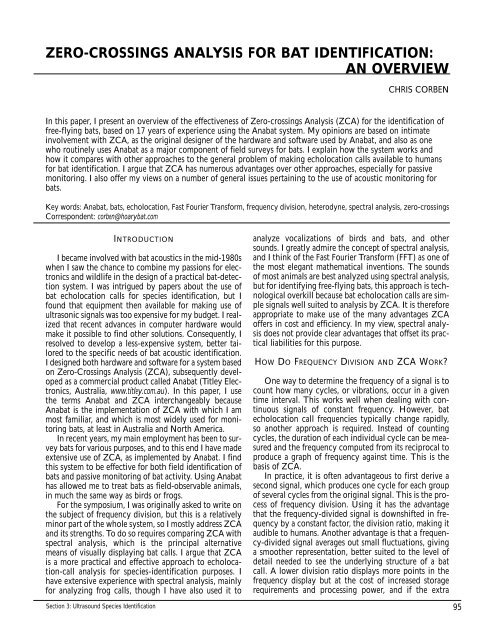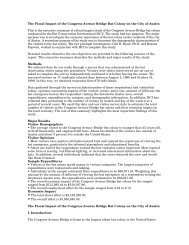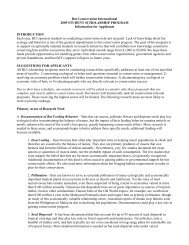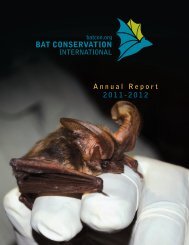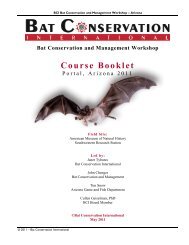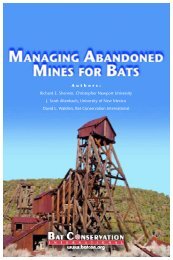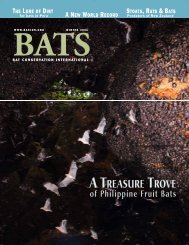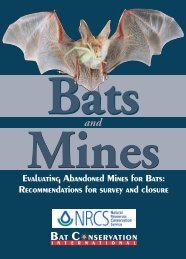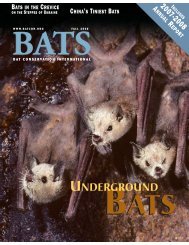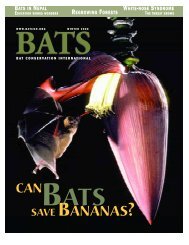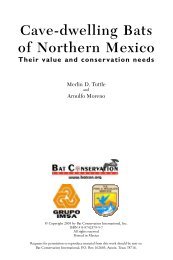Bat Echolocation Researc h - Bat Conservation International
Bat Echolocation Researc h - Bat Conservation International
Bat Echolocation Researc h - Bat Conservation International
You also want an ePaper? Increase the reach of your titles
YUMPU automatically turns print PDFs into web optimized ePapers that Google loves.
ZERO-CROSSINGS ANALYSIS FOR BAT IDENTIFICATION:<br />
AN OVERVIEW<br />
CHRIS CORBEN<br />
In this paper, I present an overview of the effectiveness of Zero-crossings Analysis (ZCA) for the identification of<br />
free-flying bats, based on 17 years of experience using the Anabat system. My opinions are based on intimate<br />
involvement with ZCA, as the original designer of the hardware and software used by Anabat, and also as one<br />
who routinely uses Anabat as a major component of field surveys for bats. I explain how the system works and<br />
how it compares with other approaches to the general problem of making echolocation calls available to humans<br />
for bat identification. I argue that ZCA has numerous advantages over other approaches, especially for passive<br />
monitoring. I also offer my views on a number of general issues pertaining to the use of acoustic monitoring for<br />
bats.<br />
Key words: Anabat, bats, echolocation, Fast Fourier Transform, frequency division, heterodyne, spectral analysis, zero-crossings<br />
Correspondent: corben@hoarybat.com<br />
INTRODUCTION<br />
I became involved with bat acoustics in the mid-1980s<br />
when I saw the chance to combine my passions for electronics<br />
and wildlife in the design of a practical bat-detection<br />
system. I was intrigued by papers about the use of<br />
bat echolocation calls for species identification, but I<br />
found that equipment then available for making use of<br />
ultrasonic signals was too expensive for my budget. I realized<br />
that recent advances in computer hardware would<br />
make it possible to find other solutions. Consequently, I<br />
resolved to develop a less-expensive system, better tailored<br />
to the specific needs of bat acoustic identification.<br />
I designed both hardware and software for a system based<br />
on Zero-Crossings Analysis (ZCA), subsequently developed<br />
as a commercial product called Anabat (Titley Electronics,<br />
Australia, www.titley.com.au). In this paper, I use<br />
the terms Anabat and ZCA interchangeably because<br />
Anabat is the implementation of ZCA with which I am<br />
most familiar, and which is most widely used for monitoring<br />
bats, at least in Australia and North America.<br />
In recent years, my main employment has been to survey<br />
bats for various purposes, and to this end I have made<br />
extensive use of ZCA, as implemented by Anabat. I find<br />
this system to be effective for both field identification of<br />
bats and passive monitoring of bat activity. Using Anabat<br />
has allowed me to treat bats as field-observable animals,<br />
in much the same way as birds or frogs.<br />
For the symposium, I was originally asked to write on<br />
the subject of frequency division, but this is a relatively<br />
minor part of the whole system, so I mostly address ZCA<br />
and its strengths. To do so requires comparing ZCA with<br />
spectral analysis, which is the principal alternative<br />
means of visually displaying bat calls. I argue that ZCA<br />
is a more practical and effective approach to echolocation-call<br />
analysis for species-identification purposes. I<br />
have extensive experience with spectral analysis, mainly<br />
for analyzing frog calls, though I have also used it to<br />
Section 3: Ultrasound Species Identification<br />
analyze vocalizations of birds and bats, and other<br />
sounds. I greatly admire the concept of spectral analysis,<br />
and I think of the Fast Fourier Transform (FFT) as one of<br />
the most elegant mathematical inventions. The sounds<br />
of most animals are best analyzed using spectral analysis,<br />
but for identifying free-flying bats, this approach is technological<br />
overkill because bat echolocation calls are simple<br />
signals well suited to analysis by ZCA. It is therefore<br />
appropriate to make use of the many advantages ZCA<br />
offers in cost and efficiency. In my view, spectral analysis<br />
does not provide clear advantages that offset its practical<br />
liabilities for this purpose.<br />
HOW DO FREQUENCY DIVISION AND ZCA WORK?<br />
One way to determine the frequency of a signal is to<br />
count how many cycles, or vibrations, occur in a given<br />
time interval. This works well when dealing with continuous<br />
signals of constant frequency. However, bat<br />
echolocation call frequencies typically change rapidly,<br />
so another approach is required. Instead of counting<br />
cycles, the duration of each individual cycle can be measured<br />
and the frequency computed from its reciprocal to<br />
produce a graph of frequency against time. This is the<br />
basis of ZCA.<br />
In practice, it is often advantageous to first derive a<br />
second signal, which produces one cycle for each group<br />
of several cycles from the original signal. This is the process<br />
of frequency division. Using it has the advantage<br />
that the frequency-divided signal is downshifted in frequency<br />
by a constant factor, the division ratio, making it<br />
audible to humans. Another advantage is that a frequency-divided<br />
signal averages out small fluctuations, giving<br />
a smoother representation, better suited to the level of<br />
detail needed to see the underlying structure of a bat<br />
call. A lower division ratio displays more points in the<br />
frequency display but at the cost of increased storage<br />
requirements and processing power, and if the extra<br />
95


